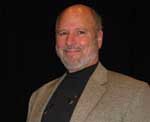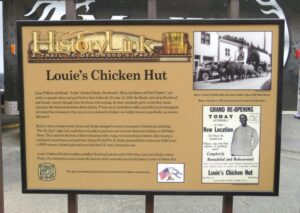By Jerry Klinger

DEADWOOD, South Dakota — The Jewish journey to Louie’s Chicken Hut in this historic western town began with severe turbulence over flyover country. Return to your seats, buckle your seat belts, and stow any loose items, the voice ordered from the speaker above my head.
Not about to argue the obvious, I stowed my computer in the seat back pocket in front of me, removing the American Airlines travel magazine to make space.
Flipping the magazine pages, I saw an article about Mt. Rushmore, 30,000 feet below us. Mt. Rushmore had been carved by Gutzon Borglum, a rabid antisemite and Klan Member. The travel to South Dakota article also referenced Deadwood, South Dakota, about 60 miles, as a crow would fly, from Mt. Rushmore.
I knew that Sol Starr, a Yiddish boy, was the first mayor of Deadwood. Wondering, as I do, when the pages shake, bouncing off the stratosphere, hoping the earth is not the next stop, I asked myself a question.
I wondered if there was a Jewish marker in Deadwood for Sol Starr mentioning he was Jewish. Could I place one? Deadwood is a major tourist attraction. Two and a half million people a year visit the historic frontier gold mining town. That would be a lot of eyes learning Jews were on the frontier.
Returning safely to Washington, I contacted the Deadwood Historic Preservation Commission officer, Jim Wilson. I asked my question, half figuring through my pink-clouded Coastal glasses that everyone in flyover country was a bigot.
I asked Jim, “The Jewish American Society for Historic Preservation might be interested in donating a marker to Deadwood if it would recognize Starr was a Jew.”
Tightening my stomach for the big rejection, Jim answered, “Thanks. There is no marker, and we would welcome one. Come on down, and I’ll show you around.”
Jim surprised my preconceived/ill-conceived assumptions about flyover country.
With Jim’s help, support from Deadwood’s Adams Museum and Ann Stanton, South Dakota’s Jewish historian, three markers were placed in Deadwood telling Deadwood’s Jewish story. Jim insisted they be placed in as visible and prominent locations as possible for the maximum number of eyeballs to see.
The first historical interpretive marker was placed opposite the Bullock Hotel. Seth Bullock, the first sheriff of Deadwood, was Sol Starr’s partner. The marker had a map of the many Jewish businesses in downtown Deadwood that enabled the economy to work. As did all the Jewish markers that we placed in Deadwood; it had a large Star of David on it.
Stars of David get eyeballs. I even received an email from a Motorcycle Biker who had participated in the annual Sturgis Bike gathering. He shared that he was astonished. He had written his mother, “Mom, you won’t believe it. There were Jews here in Deadwood. Just like me!”
The second marker was at the Franklin house, named for a Jewish man who made his fortune in ranching and mining. Touring the house, a menorah sits on the mantel above the fireplace. His daughter, Blanche, became the first female attorney admitted to the Bar in South Dakota.
The third marker, Jim wanted specifically sited near the gravesites of Calamity Jane and Wild Bill Hickock in the Mt. Moriah cemetery above Deadwood. Jim said, “I want it here because this is where the tour buses stop.” The marker references the Jewish cemetery, a bit above Wild Bill, on Jerusalem Street.
From Deadwood, JASHP continued its Jewish journey in South Dakota. A marker was funded and placed for the father of Mt. Rushmore, Doane Robinson. Robinson wasn’t Jewish. That did not matter; he did something for all of us, for all Americans, by creating the Mt. Rushmore project.
JASHP did do something to get in the face of Gutzon Borglum, the antisemite who carved Mt. Rushmore. Borglum specifically prohibited Jewish carvers from participating in the great American endeavor.
At Mt. Rushmore’s Grandview Plaza, for the first time, the word Jew was added. A credit line recognizes the Jewish American Society for Historic Preservation as a significant donor to Mt. Rushmore’s preservation.
JASHP partnered with the Minnehaha County Historical Society to place a Jewish historical marker in Sioux Falls. The first permanent Jewish house of worship in South Dakota, Congregation Sons of Israel, Sioux Falls, was established in 1916. The marker’s text introduced many to Jewish South Dakota history:
“Since the territorial days of the 1870s, Jewish people have played an important role in the social, economic, and cultural life of South Dakota. In the 1880s, Sioux Falls experienced an influx of Reformed Jews from Germany, who became some of the city’s leading merchants and entrepreneurs.”
About 800 feet away from the Sons of Israel marker in Van Epps Park is another marker. It is dedicated to Martin Luther King. King came to Sioux Falls in 1961 to speak about the struggle for equality for all Americans.

Keeping in contact with Deadwood’s Historic Preservation Commission, an opportunity came up to fund an interpretive marker that tangentially touched on Deadwood’s Black historical experience. JASHP agreed to fund the marker for Louie’s Chicken Hut provided JASHP could put its logo, the crossed flags of the United States and Israel above a Lion of Judah, on the credit line.
Mike Runge, the Commission’s archivist, said, “It was not an issue.”
Louis Bank and his wife Jackie were not major historical movers in Deadwood. What attracted JASHP was the commonality of their story as Americans.
The American West was a collage of diversity, Blacks, Whites, Native Americans, Chinese, Hispanics, Christians, Jews, Buddhists, agnostics, atheists, and more. They came together in the West. The West first measured what a person brought to the table, not by their race or religion.
It is not that there was no prejudice and stupidity. There was. Freedom is a process, not a finished product. The melting pot, at times hot and other times cold, resulted in a commonality, Americans.
JASHP was glad to fund the marker project.
The marker text reads:
Louis William and Emily “Jackie” (Jordan) Banks, Deadwood’s “King and Queen of Fried Chicken,” put smiles on people’s faces and good food in their bellies for 35 years. In 1928, the Banks arrived in Deadwood and became renown through their Southern style cooking. As their popularity grew, so did their menu selections that featured Southern fried chicken, T-bone steak, fresh fried catfish, and chili. Local newspapers advertised the restaurant often, one ad even pictured well-liked and widely known, Louis Banks, as seen on this panel.
Early in their cooking careers, Louis and Jackie managed several restaurants in Deadwood, including “The Ole Style” night club, until they were able to purchase and renovate their own building at 558 Main Street. They adorned the front of their restaurant with a large, two-colored chicken that became a landmark of good times and good food. During World War II, Jackie operated their restaurant while Louis, a WWI veteran, enlisted again and served in the U.S. Army during the war.
Louie’s Chicken Hut fed countless satisfied Deadwood patrons until 1963, when Louis and Jackie retired. Today, the interpretive panel marks the location of the successful and locally famous Louie’s Chicken Hut.”
Photo courtesy of Mike Runge.
If an opportunity to fund a historical marker for Deadwood’s Chinese community or to restore the gravesite of Deadwood Dick on Sunrise Mountain comes around, JASHP is interested.
*
Jerry Klinger is the President of the Jewish American Society for Historic Preservation.